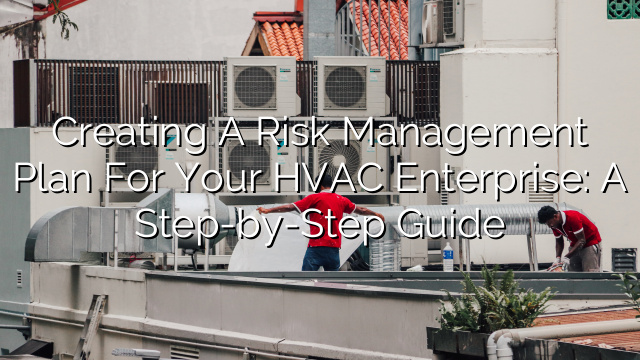Introduction
Running an HVAC enterprise comes with its fair share of risks. From unexpected equipment breakdowns to accidents on the job, there are numerous factors that can disrupt your business operations and affect your bottom line. To protect your HVAC enterprise from potential risks, it’s important to have a comprehensive risk management plan in place.
In this step-by-step guide, we’ll walk you through the process of creating a risk management plan for your HVAC enterprise. By following these steps, you’ll be able to identify and assess potential risks, implement preventive measures, and develop contingency plans to mitigate any potential damage.
Step 1: Identify Potential Risks
The first step in creating a risk management plan is to identify potential risks that your HVAC enterprise may face. This can include both external factors, such as natural disasters or economic changes, as well as internal factors, such as equipment failures or employee errors. It’s important to conduct a thorough assessment of all possible risks to ensure that your plan is comprehensive.
Step 2: Assess Risks
Once you have identified potential risks, the next step is to assess their likelihood and impact on your HVAC enterprise. This involves determining the probability of each risk occurring and estimating the potential damage or loss that may result. This step will help you prioritize your risks and focus on those that pose the greatest threat to your business.
Step 3: Implement Preventive Measures
After assessing the risks, it’s time to implement preventive measures to reduce the likelihood of these risks occurring. This can include regular equipment maintenance, implementing safety protocols for employees, or securing insurance coverage for potential damages. By taking proactive steps to prevent risks, you’ll be able to minimize the impact on your HVAC enterprise.
Step 4: Develop a Contingency Plan
While preventive measures are essential, it’s also important to have a contingency plan in place in case a risk does materialize. This involves outlining specific steps to be taken in the event of a risk occurrence, including communication protocols, alternative business arrangements, and procedures for accessing emergency funds. Having a detailed contingency plan will help you respond effectively to any unexpected situations.
Step 5: Monitor and Review
Creating a risk management plan isn’t a one-time activity. It’s important to continuously monitor and review your plan to ensure its effectiveness. This involves regularly reassessing potential risks, reviewing preventive measures, and updating your contingency plan as necessary. By staying vigilant and proactive, you’ll be able to adapt to changing circumstances and protect your HVAC enterprise from potential risks.
FAQs
1. What are some common risks in the HVAC industry?
Some common risks in the HVAC industry include equipment breakdowns, accidents on the job, economic downturns, natural disasters, and employee errors.
2. Why is it important to have a risk management plan?
Having a risk management plan is important because it helps you identify and assess potential risks, implement preventative measures, and develop contingency plans. This allows you to protect your HVAC enterprise from potential disruptions and minimize any potential damage.
3. How often should I review my risk management plan?
It is recommended to review your risk management plan on an annual basis or whenever there are significant changes in your business operations or the external environment. This ensures that your plan remains up-to-date and effective.
4. Should I involve my employees in the risk management process?
Yes, it is highly recommended to involve your employees in the risk management process. They can provide valuable insights and perspectives on potential risks and help identify opportunities for improvement.
5. Can insurance coverage replace a risk management plan?
While insurance coverage can provide financial protection, it should not be seen as a substitute for a risk management plan. Insurance coverage is reactive, whereas a risk management plan allows you to take proactive measures to prevent or minimize risks. It is important to have both in place for comprehensive risk management.






